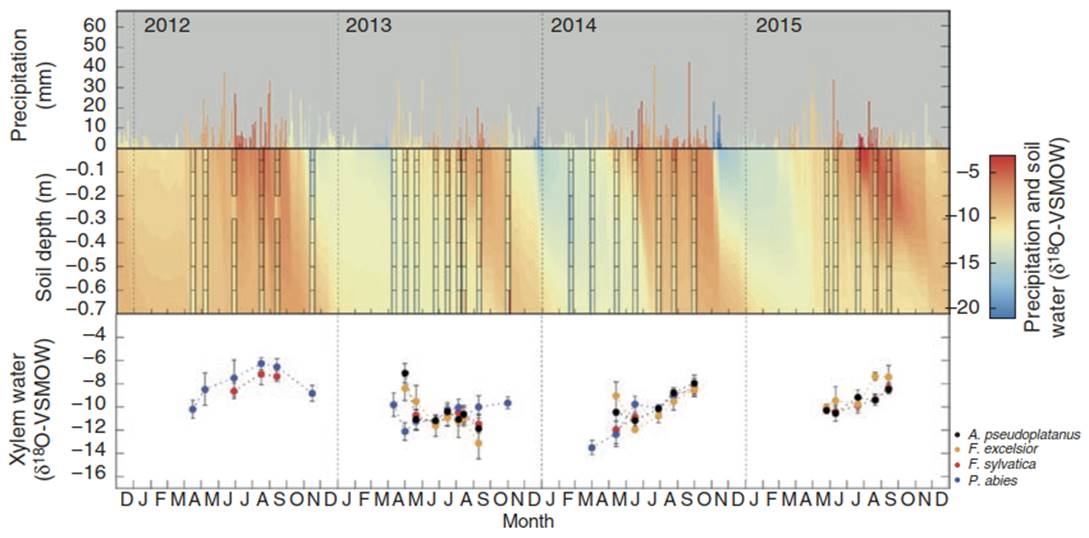Water Uptake of Trees
All plants need water to survive, for evapotrans- piration as well as to maintain their turgor and to grow. Plant water uptake is typically via the roots from the soil, although some plant species also rely on fog, for example, in deserts and montane cloud forests, not only epiphytes. Identifying and quantifying plant water uptake based on the distribution of roots is difficult for two reasons:
- The presence of roots at a certain depth does not necessarily mean that roots take up water at this depth.
- Not all roots found in the soil are physiologically active.
- Assigning roots, particularly fine roots, to different species when studying a plant community is almost impossible. Genetic analyses have been used to determine the species, after roots have been dug out of the soil, but this approach is very laborious and expensive. More recently, near-infrared analyses of dried root material have been used to determine species identity, but this approach has a high uncertainty.
An alternative approach is to use stable isotopes of water, either oxygen or hydrogen isotope ratios (δ18O or δ2H, respectively), to determine the soil water source or the rooting depth of water uptake. However, since precipitation changes its isotopic signature seasonally (Fig. 16.3), due to changes in temperature, atmospheric water vapour pressure and origin of air masses (Gat 1996), frequent sampling and hydrological modelling of the isotope ratios in soil water will best account for the biogeochemical variations of this important plant resource. Since no isotope fractionation takes place during root water uptake, isotope ratios in xylem water reflect the total soil water uptake of a plant.

Fig. 16.3. Stable isotope ratios of oxygen in precipitation, soil water and xylem water. Oxygen isotope ratios were analysed with an isotope ratio mass spectrometer in precipitation samples, soil water of eight different depths, and in xylem water of four dominant tree species (Fagus sylvatica, Picea abies, Fraxinus excelsior, Acer pseudoplatanus) in a mixed forest (Lageren, Switzerland) over 4 years. Coloured areas along the soil profiles were modelled using a soil hydraulic model. (Data from Brinkmann 2016)
Nontranspiring tissues need to be sampled for these measurements, that is, root collars (Barnard et al. 2006), branches or twigs (Ehleringer et al. 2000), to avoid evaporative enrichment: During evaporation, lighter water molecules evaporate faster, so the remaining water pool becomes enriched in the heavier isotopes and no longer reflects the original water source. In a mixed forest, oxygen stable isotope ratios in soil water follow the precipitation inputs with some time lags, particularly in deeper soil layers, while the isotopic signatures in xylem water of temperate tree species show a pronounced seasonal course, but species also differ (Fig. 16.3).
Mixing of existing water pools in the soil profile with rain infiltrating into the soil depends on the soil structure, soil moisture content and precipitation regime. Based on these variables, the mean residence time of water at a particular soil depth can be modelled (Fig. 16.4). Such models account for preferential flow through macro pores (e.g. earthworm casts, root channels, cracks), which can lead to very high flow rates (within days).

Fig. 16.4. Precipitation and mean residence time of soil water. Precipitation was collected in a mixed forest (Lageren, Switzerland) over 4 years. Mean residence time of soil water at 0-0.8 m soil depth was modelled using a soil hydraulic model based on oxygen isotope ratio measurements. The colour scale indicates the mean residence time of soil water at a given depth. Dashed lines indicate the mean residence time of soil water at 30, 60, 120, 240 and 360 days. (Data from Brinkmann 2016)
The “age” of water is higher at greater depths in the soil profile, and mean residence times can reach more than 1 year at a depth of 0.8 m. At more shallow depths, the impact of current precipitation is prevalent, and water pools mix over a period of about a month. Combining this information with the isotopic signatures of xylem water shows that P. abies takes up water from more shallow soil depths, while F. sylvatica, A. pseudoplatanus and F excelsior take up water from deeper horizons. Since soil water is the ultimate pool to supply water for tree transpiration, susceptibility to short dry spells or droughts will also differ among these species (all other drivers for evapotranspiration being equal).
Date added: 2025-02-05; views: 296;
